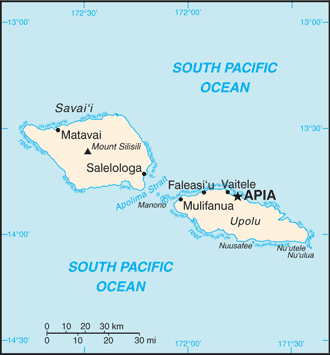Samoa


Continent – Australasia, Oceania
Region – Pacific Islands
Size – 2,821 km²
Geography – collection of volcanic, mountainous islands with coastal plains
Language – Samoan (official), English
Religion – Protestant 57.4%, Roman Catholic 19.4%, Mormon 15.2%, other 8%
Monetary Unit – Samoan Tala
Natural Resources – hardwood forests, fish, hydropower
Agriculture – coconuts, nonu, bananas, taro, yams, coffee, cocoa
Industry – food processing, building materials, auto parts

Neighbouring Countries – None
Population – 197,773 (2015 estimate)
Population Growth Rate – 0.58%
Average Life Expectancy – 73.46
Capital City – Apia (37,000)
Highest Mountain – Mount Silisili (1,857 m)
Longest River – Vaisigano River
Climate – tropical – hot all year round 24°C – 31°C
Yearly Rainfall – 280 cm (approx) mostly November to May
Plant Life – rainforest vegetation, ferns, teuila, mangrove forests, pandanus, Barringtonia, hibiscus
Animal Life – fruit bat, rat, flying fox, snakes, lizards, gecko
Bird Life – tooth-billed pigeon, doves, parrots, pigeons, wild duck
Marine Life – coral, marine and tropical fish, turtles
Harvard Reference for this page:
Heather Y Wheeler. (2015). Samoa. Available: https://www.naturalhistoryonthenet.com/Facts_Figures/Country_Facts/samoa.htm. Last accessed Tuesday, July 19, 2016
Facts and Figures Pages
